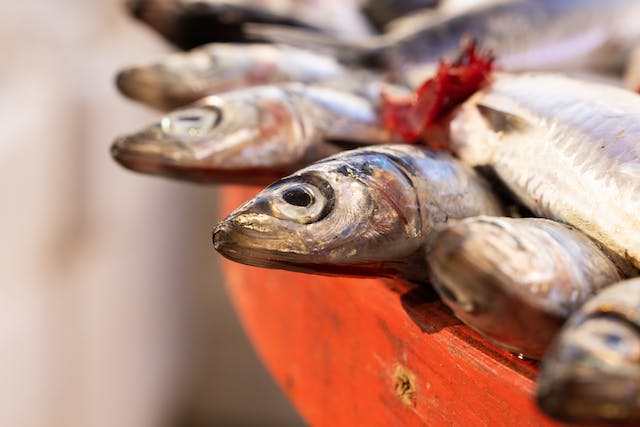
As committed pet parents, we work hard to give our animals the best food possible. Many people have wondered Can dog eat fish? in light of the ongoing discussion over what makes a healthy diet for dogs. Experts in animal nutrition, pet owners, and veterinarians have all had conversations on this topic. We’ll go into the several facets of feeding fish to dogs in this extensive essay, including the possible advantages and disadvantages of adding this marine protein to your dog’s diet.
Table of Contents
can dog eat fish?
Fish’s Nutritious Value for Dogs:

Fish is widely recognized for its abundant nutritional composition, providing a multitude of vital elements that can enhance a dog’s general health. The following essential elements, which are present in fish, can help your pet:
1. Omega-3 Fatty Acids: Fish is a great source of omega-3 fatty acids, especially fatty fish like trout, salmon, and mackerel. These vital fatty acids are critical for maintaining a dog’s healthy coat, lowering inflammation, and enhancing cognitive performance.
2. Protein: Fish is an excellent source of protein and a must-have food for dogs. Protein is essential for general growth, tissue repair, and muscular development. Including fish in your dog’s food can help ensure that their protein intake is balanced.
3. Vitamins and Minerals: Vitamin D, B12, iodine, and selenium are among the vitamins and minerals found in fish that are crucial for bone health, energy metabolism, and immune system function as a whole.
4. simple to Digest: Fish is often simple for dogs to digest, which means that dogs with sensitive stomachs or allergies to certain foods might benefit from eating it as a source of protein. Even though fish has many nutritional advantages, you should always feed fish to your dog carefully and take any potential risks into account.
Possible Dangers of Giving Dogs Fish to Eat:
While fish can be a beneficial addition to a dog’s diet, pet owners should be aware of the following possible risks and factors:
1. Mercury Content: Mercury is a heavy metal that can be dangerous in high concentrations, and certain fish species may have higher concentrations of it. Fish that are predators, like swordfish and sharks, typically have higher mercury accumulation rates. For this reason, when feeding your dog fish, it’s imperative to select fish with a lower mercury content.
2. Fish bones: If consumed by dogs, fish bones can be a choking hazard or cause digestive problems. Make sure the fish is always cooked without bones and prepared in a way that removes any possible hazards related to bones.
3. Allergies: Dogs can have allergies to fish just like they can to any other food. When adding fish to your dog’s diet, keep a close eye out for any indications of an allergic reaction, such as swelling, itching, or gastrointestinal distress.
4. Preparation and Seasoning: Fish cooked with oils, seasonings, or other ingredients might not be dog-friendly. Common ingredients in human cuisine like garlic and onions can be poisonous to dogs. It’s crucial to give your dog cooked fish that hasn’t had any additional ingredients added.
Dog Feeding Guidelines

Should you choose to add fish to your dog’s diet, make sure to adhere to these guidelines in order to provide a healthy and safe feeding experience:
1. Select Safe Fish Varieties: Go for fish varieties like salmon, trout, and whitefish that have lower mercury content. Fish that has been undercooked or served raw to your dog increases the risk of bacterial contamination.
2. Remove Bones: Before giving fish to your dog, always remove the bones. Fish bones can break and result in internal injuries or choking.
3. Cook Totally: To get rid of any potentially dangerous bacteria or parasites, cook fish completely. Steer clear of using any additives, seasonings, or oils that might be toxic to dogs.
4. Monitor for Allergic Reactions: Introduce fish gradually into your dog’s diet and monitor for any signs of allergies. If you observe any adverse reactions, consult with your veterinarian.
5. Portion Control: Fish should be offered as a treat or supplement to your dog’s regular diet, not as a primary food source. Maintain a balanced diet with a variety of protein sources to ensure your dog receives all the necessary nutrients.
Conclusion:
In conclusion, there is a complex response to the question, Can dog eat fish?. Dogs can benefit greatly from the nutrients and health benefits that fish can offer, but it’s important to weigh the risks associated with this dietary choice carefully. You can safely add fish to your dog’s diet as a wholesome treat on occasion by choosing safe fish varieties, cooking them properly, and keeping an eye out for any negative reactions. As usual, speak with your veterinarian to ensure your dog’s general health and customize their diet to meet their unique needs.
Can dog eat fish?
1. Can I feed any type of fish to my dog?
Not all fish are created equal when it comes to canine consumption. While certain fish, such as salmon, trout, and whitefish, are generally safe for dogs, predatory fish like shark and swordfish may contain higher levels of mercury. It’s essential to choose fish varieties with lower mercury content and ensure they are boneless, thoroughly cooked, and free from harmful additives before offering them to your dog.
2. How often should I include fish in my dog’s diet?
Fish should be considered a supplemental protein source in your dog’s diet, rather than a primary food source. Aim to include fish in your dog’s meals as an occasional treat, not exceeding more than 10% of their overall diet. This ensures a well-rounded and balanced nutritional intake while minimizing the potential risks associated with excessive fish consumption, such as mercury exposure or allergic reactions.
3. What signs should I look for to detect fish allergies in my dog?
Allergies to fish can manifest in various ways in dogs. Watch for signs such as itching, redness, swelling, gastrointestinal distress, vomiting, or diarrhea. If you notice any of these symptoms after introducing fish into your dog’s diet, it’s crucial to consult with your veterinarian promptly. They can help determine whether the reaction is due to a fish allergy or another underlying issue, providing appropriate guidance for your dog’s dietary needs.
